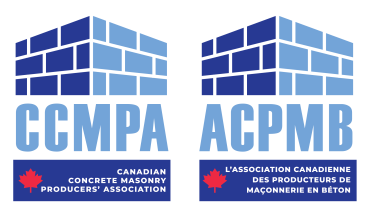
Are you in the know?
I'm Andrea McChesney, the Executive Director of the CCMPA, and we want to ensure you and your team have all the access to the latest and greatest in CCMPA activities and industry buzz.
Sincerely, Andrea & your CCMPA team.


TORONTO — FEBRUARY 1, 2013 — Mandatory sprinklers in Ontario retirement homes are a big step in the right direction but seniors also need the protection of more fire-resistant building material such as concrete block. This statement from construction and fire-safety representatives comes in response to proposed changes put forward by an Ontario Government task force reviewing the province’s Fire and Building Code.
“Sprinklers are only the first step,” says Paul Hargest, President of the Canadian Concrete Masonry Producers Association (CCMPA). “This is especially true in newer building areas where septic and well systems may rely on pumps — pumps that will stop functioning if the power goes out, a likely possibility not only in the event of a fire but also as a result of the extreme weather we’re experiencing due to climate change.”
Studies conducted by the U.S.-based National Concrete Masonry Association (NCMA) show that the best fire protection is provided through “balanced design”, which is a combination of:
All four methods should be applied in all building construction, but especially in places where age and frailty can make escaping a fire especially difficult. The challenges and tragic consequences of fires in retirement homes were made particularly evident in January 2009 when, within days of each other, two fires in large retirement homes in Orillia, Ontario and Saguenay, Quebec killed several residents and forced hundreds of others out into bitter temperatures in bare feet and pajamas. Saguenay’s mayor commented that, “The whole building burned; the walls fell in.”
This structural collapse — a common occurrence when fire strikes newer buildings constructed with combustible building materials — can render sprinkler systems useless and pose enormous additional risk, not only for people trying to exit the building but for fire fighters entering it.
“The widespread use of lightweight construction and contents made from oil- based/synthetic materials throughout buildings today means that when they catch fire, they burn with more intensity than ever before,” says Carl G. Pearson, Immediate Past President, Fire Fighters’ Association of Ontario. “A material like concrete masonry as a partitioning wall can significantly slow the spread of the blaze and maintain structural integrity, both critical to helping save lives.”
Commonly used drywall and wood frame currently receive acceptable ‘fire resistance’ ratings in industry laboratory testing; however, as real-life situations like Orillia and Saguenay show, these materials burn quickly — much faster than the times suggested by laboratory testing — and are fully ablaze well before staff are able to move dozens or even hundreds of residents out of a nursing home.
“We need to be realistic about the time it takes for such residents, many using walkers or wheelchairs, to exit a burning building,” says CCMPA’s Paul Hargest. “Their chances of escape are considerably reduced in a structure built only with wood and drywall.”
Concrete masonry, in comparison, remains standing and has proven to be an effective barrier in fires where half a structure has been razed and the other half — divided by a concrete block wall — has remained structurally intact.
“Stepping up our building codes is vital for the safety of seniors — but it’s important for the safety of all Canadians,” says Paul Hargest. “The risks of fire. The increasing incidence of severe storms. The spread of termites. The improper use of firearms. The annoyance and ill-effects of noise. All of these are reasons why we need to build better, stronger buildings that will not only house us, but protect us. If the Ontario government is serious about protecting seniors or other vulnerable individuals, they need to review and support balanced design.”
Public comments on the proposed changes to the code can be made until Feb. 28, 2013: http://www.mcscs.jus.gov.on.ca/english/FireMarshal/PublicConsultationTAC/Overview/OFM_TAC_Overview.htm?SSContributor=true
ABOUT CCMPA
The Canadian Concrete Masonry Producers Association operates as Region 6 of the National Concrete Masonry Association, and is the representative voice for the Canadian concrete block manufacturing industry. The Association supports concrete masonry producers and suppliers in a number of areas including standards, training, technological research, government relations, and marketing and communications. Through these areas, the Association works to ensure the highest standards of quality and maintain the industry’s strong market presence.
For more information or to interview Paul Hargest, contact:
Marina de Souza
Managing Director, CCMPA
Toll Free: 1-888-495-7497
Phone: 416-495-7497
Fax: 416-495-8939
mdesouza@ccmpa.ca